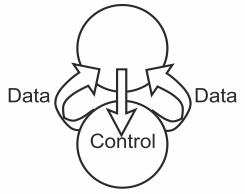

Normally, you would see an ad here. Maybe you are using an ad blocker. I respect that, but this site relies on revenue from ads to continue. Maybe as an alternative you would consider making a donation on the Contribute page.
Normally, you would see an ad here. Maybe you are using an ad blocker. I respect that, but this site relies on revenue from ads to continue. Maybe as an alternative you would consider making a donation on the Contribute page.
Copyright © Sirius Publishing 2006-2019



Downward Causation
This model contains a logical hierarchy with the physical system at the ‘bottom’ and the absolute system at the ‘top’. This says nothing about any actual physical positioning, but is a necessary way of visualising and describing the model.
Donald T. Campbell (Campbell, 1990.) originally formulated the principle of downward causation as ‘all processes at the lower level of a hierarchy are restrained by and act in conformity to the laws of the higher level’.
Hold that thought as we begin to construct our model of awareness. We have already established that lower systems collate information and feed it up to the next system above it. This process is then repeated in this next system until we reach the absolute system. From a cybernetic perspective we say that the lower system sends data to the higher system. But what of the higher system? In conformance with the law of downward causation this sends control information to the lower system.
established that lower systems collate information and feed it up to the next system above it. This process is then repeated in this next system until we reach the absolute system. From a cybernetic perspective we say that the lower system sends data to the higher system. But what of the higher system? In conformance with the law of downward causation this sends control information to the lower system.
There is a logical necessity for the higher system to exert control on the lower. The higher system directs the attention of the lower system otherwise the lower system would be randomly sampling data from its environment with no limit or concentration. This would be highly inefficient and evolutionarily disadvantageous.
We can say that the ‘lower’ system reacts to the ‘higher’ or that the ‘higher’ system constrains the ‘lower’. Either way we are talking about the same interaction but from different points of view. However emphasis here is being placed on downward causation since the higher system can exhibit processes that are not determined by the lower but the lower system cannot have a process that is not determined by the higher.
The whole is to some degree constrained by the parts (upward feedback), but at the same time the parts are mostly constrained by the whole (downward causation). For instance, it is well known that snow crystals have a strict 6-fold symmetry, but at the same time each crystal has a unique symmetric shape. The symmetry of the crystal (whole) is clearly determined by the physico-chemical properties of the water molecules that constitute it. But on the other hand, the molecules do not determine the shape of the complete crystal. Once a shape has been formed, though, the molecules in the crystal are constrained: they can only be present at particular places allowed in the symmetric crystalline shape. The whole (crystal) constrains or "causes" the positions of the parts (molecules).
This relates directly to the relative merits of reductionism verses holism. Reductionism holds that if you know the laws governing the behaviour of the parts, you should be able to deduce the laws governing the behaviour of the whole. Systems theory is anti-reductionist, holding that the whole is more than the sum of the parts. In other words, the whole has "emergent properties" which cannot be reduced to properties of the parts. Emergence can also be expressed as the more precise concept of downward causation.
The same principle applies to less rigid/mechanistic systems such as living organisms. You cannot have organisms whose internal functioning flouts the rules of physics and chemistry. However, the laws of physics are completely insufficient to determine which shapes or organisations will evolve in the living world. Once a particular biological organisation has emerged, it will strongly constrain the behaviour of its components.
Most importantly for our model, once a particular system has emerged, its organisation and function is constrained by the environment it inhabits, or to put it another way, the higher system of which it is a subsystem.